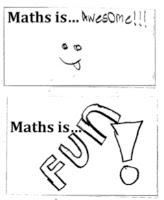...and how it relates to multiplication facts
Alright - we all know this remarkable feature of multiplication.
And we already know the formula because someone taught us back in high school:
area = base x height
But what about my team of Year 4 kids?
What links could they find between area and multiplication facts?
So we started with some coloured rectangles, carefully cut to be pretty close to whole centimetres.
Then, using our multilink cubes we worked out how many we would need to cover the shape.
Much discussion ensued using words such as "area", "length", "height", "centimetre", "compare", "larger", "smaller" etc
"Ah, yes! 3 rows of 6 cubes. So the area is 18 square centimetres!"

And then the moment of epiphany!
Like a crack in the dam wall, the realisation came that we don't need to cover the whole shape.
We can in fact use our knowledge of multiplication facts to simplify this task.
So instead of putting out 150 centicubes, I only need to know the length of the base and the height.
Viola! 10 x 15 = 150
The final step was to compare the areas of larger shapes.
Who had the biggest rectangle? How do we know? How can you prove it?
So what?
This may not seem too spectacular for a lesson idea, but the lights really came on for a few individuals in the class. Sometimes what seems obvious to us adults really is remarkable to kids.
 This brief post is dedicated to an enthusiastic and energetic young man who took up the idea to do something kinesthetic while learning times tables facts. This is a great strategy to combine left- and right-brain and get things really embedded in the memory.
This brief post is dedicated to an enthusiastic and energetic young man who took up the idea to do something kinesthetic while learning times tables facts. This is a great strategy to combine left- and right-brain and get things really embedded in the memory.




























